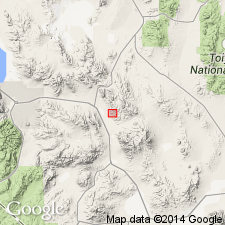
- Usage in publication:
-
- Muller Canyon Member
- Modifications:
-
- Named
- Biostratigraphic dating
- AAPG geologic province:
-
- Great Basin province
Summary:
Unit is named the Muller Canyon Member of the Gabbs Formation (revised) of the Volcano Peak Group (new). Is exposed in the Gabbs Valley Range in west-central Nevada. The Muller Canyon Member includes most of the upper member of Muller and Ferguson (1939, GSA Bull., v. 50, no. 10, p. 1573-1624) of the Gabbs Formation and the 10 m of unfossiliferous shales designated by them as the boundary between the Gabbs and Sunrise Formations. Consists of pinkish sandy siltstone that has small-scale cross-laminations and numerous thin gypsum beds. Sharply and conformably overlies the Mount Hyatt Member (new) of the Gabbs Formation; conformably underlies the Ferguson Hill Member (new) of the Sunrise Formation, both of the Volcano Peak Group. Maximum thickness is 15 m. Age is Late Triassic (Norian), based on fossils.
Type locality: exposures on the east flank of Ferguson Hill along the west side of Muller Canyon, Gabbs Valley Range, Mineral Co., NV. This section is proposed as the stratotype for the Triassic-Jurassic System boundary.
Source: US geologic names lexicon (USGS Bull. 1565, p. 213-214); GNU records (USGS DDS-6; Menlo GNULEX).
For more information, please contact Nancy Stamm, Geologic Names Committee Secretary.
Asterisk (*) indicates published by U.S. Geological Survey authors.
"No current usage" (†) implies that a name has been abandoned or has fallen into disuse. Former usage and, if known, replacement name given in parentheses ( ).
Slash (/) indicates name conflicts with nomenclatural guidelines (CSN, 1933; ACSN, 1961, 1970; NACSN, 1983, 2005, 2021). May be explained within brackets ([ ]).

